A Literary Study of Silent Spring by Rachel Carson: An Analysis
VerifiedAdded on 2020/05/04
|9
|1896
|268
Essay
AI Summary
This essay provides a literary study of Rachel Carson's groundbreaking book, Silent Spring. It delves into the historical context of the book's publication in 1962, its focus on the detrimental effects of pesticides, particularly DDT, on the environment and human health. The analysis examines Carson's writing style, her use of allegory, and her arguments against the chemical industry's practices. It also explores the book's influence on the environmental movement and its lasting legacy in raising public awareness about environmental issues. The essay discusses the criticisms and controversies surrounding the book's publication, the personal attacks on Carson, and the book's enduring relevance in the face of ongoing environmental challenges. It highlights Carson's call for a re-evaluation of humanity's relationship with nature and the need for responsible environmental stewardship, emphasizing the significance of the book as a catalyst for change and a milestone in the 20th century.
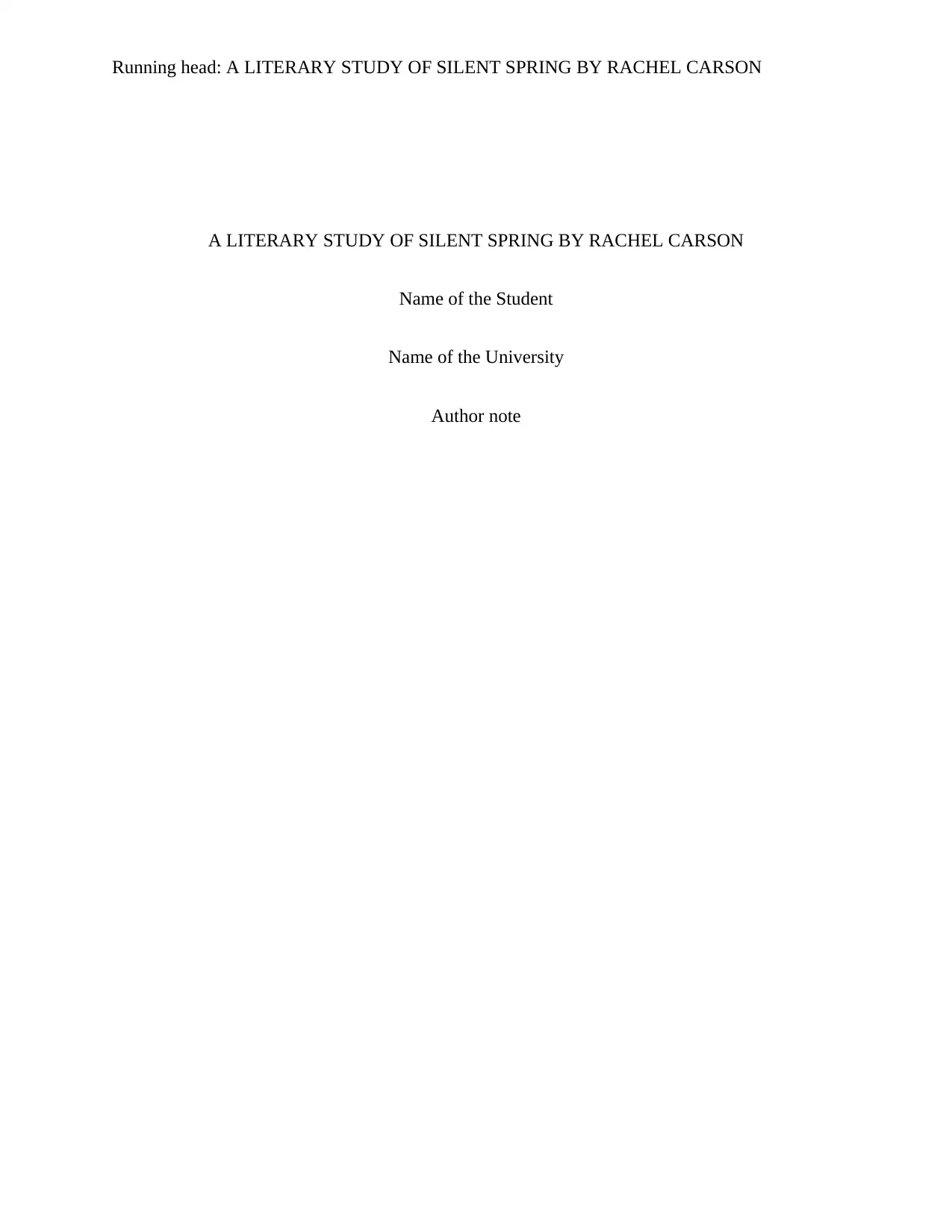
Running head: A LITERARY STUDY OF SILENT SPRING BY RACHEL CARSON
A LITERARY STUDY OF SILENT SPRING BY RACHEL CARSON
Name of the Student
Name of the University
Author note
A LITERARY STUDY OF SILENT SPRING BY RACHEL CARSON
Name of the Student
Name of the University
Author note
Paraphrase This Document
Need a fresh take? Get an instant paraphrase of this document with our AI Paraphraser
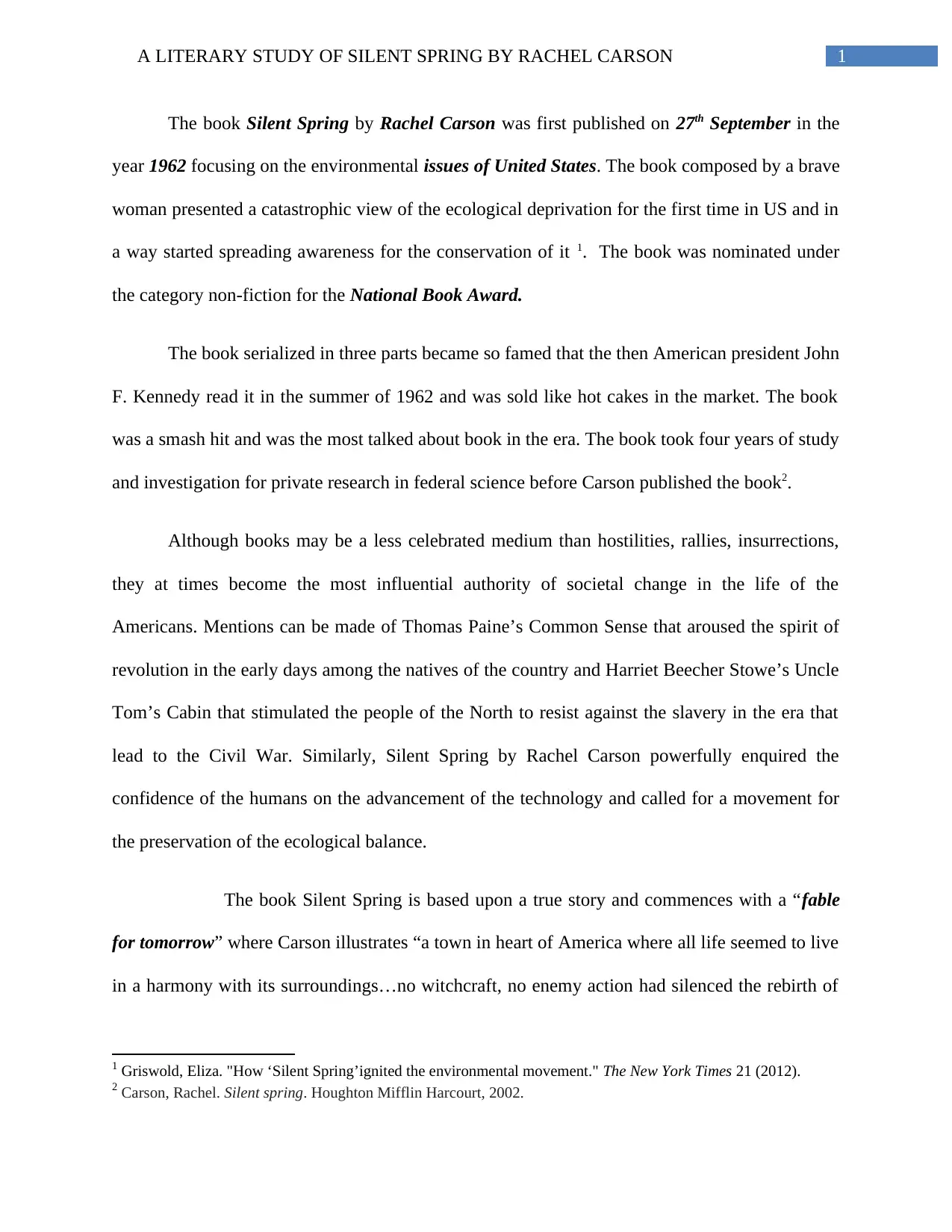
1A LITERARY STUDY OF SILENT SPRING BY RACHEL CARSON
The book Silent Spring by Rachel Carson was first published on 27th September in the
year 1962 focusing on the environmental issues of United States. The book composed by a brave
woman presented a catastrophic view of the ecological deprivation for the first time in US and in
a way started spreading awareness for the conservation of it 1. The book was nominated under
the category non-fiction for the National Book Award.
The book serialized in three parts became so famed that the then American president John
F. Kennedy read it in the summer of 1962 and was sold like hot cakes in the market. The book
was a smash hit and was the most talked about book in the era. The book took four years of study
and investigation for private research in federal science before Carson published the book2.
Although books may be a less celebrated medium than hostilities, rallies, insurrections,
they at times become the most influential authority of societal change in the life of the
Americans. Mentions can be made of Thomas Paine’s Common Sense that aroused the spirit of
revolution in the early days among the natives of the country and Harriet Beecher Stowe’s Uncle
Tom’s Cabin that stimulated the people of the North to resist against the slavery in the era that
lead to the Civil War. Similarly, Silent Spring by Rachel Carson powerfully enquired the
confidence of the humans on the advancement of the technology and called for a movement for
the preservation of the ecological balance.
The book Silent Spring is based upon a true story and commences with a “fable
for tomorrow” where Carson illustrates “a town in heart of America where all life seemed to live
in a harmony with its surroundings…no witchcraft, no enemy action had silenced the rebirth of
1 Griswold, Eliza. "How ‘Silent Spring’ignited the environmental movement." The New York Times 21 (2012).
2 Carson, Rachel. Silent spring. Houghton Mifflin Harcourt, 2002.
The book Silent Spring by Rachel Carson was first published on 27th September in the
year 1962 focusing on the environmental issues of United States. The book composed by a brave
woman presented a catastrophic view of the ecological deprivation for the first time in US and in
a way started spreading awareness for the conservation of it 1. The book was nominated under
the category non-fiction for the National Book Award.
The book serialized in three parts became so famed that the then American president John
F. Kennedy read it in the summer of 1962 and was sold like hot cakes in the market. The book
was a smash hit and was the most talked about book in the era. The book took four years of study
and investigation for private research in federal science before Carson published the book2.
Although books may be a less celebrated medium than hostilities, rallies, insurrections,
they at times become the most influential authority of societal change in the life of the
Americans. Mentions can be made of Thomas Paine’s Common Sense that aroused the spirit of
revolution in the early days among the natives of the country and Harriet Beecher Stowe’s Uncle
Tom’s Cabin that stimulated the people of the North to resist against the slavery in the era that
lead to the Civil War. Similarly, Silent Spring by Rachel Carson powerfully enquired the
confidence of the humans on the advancement of the technology and called for a movement for
the preservation of the ecological balance.
The book Silent Spring is based upon a true story and commences with a “fable
for tomorrow” where Carson illustrates “a town in heart of America where all life seemed to live
in a harmony with its surroundings…no witchcraft, no enemy action had silenced the rebirth of
1 Griswold, Eliza. "How ‘Silent Spring’ignited the environmental movement." The New York Times 21 (2012).
2 Carson, Rachel. Silent spring. Houghton Mifflin Harcourt, 2002.
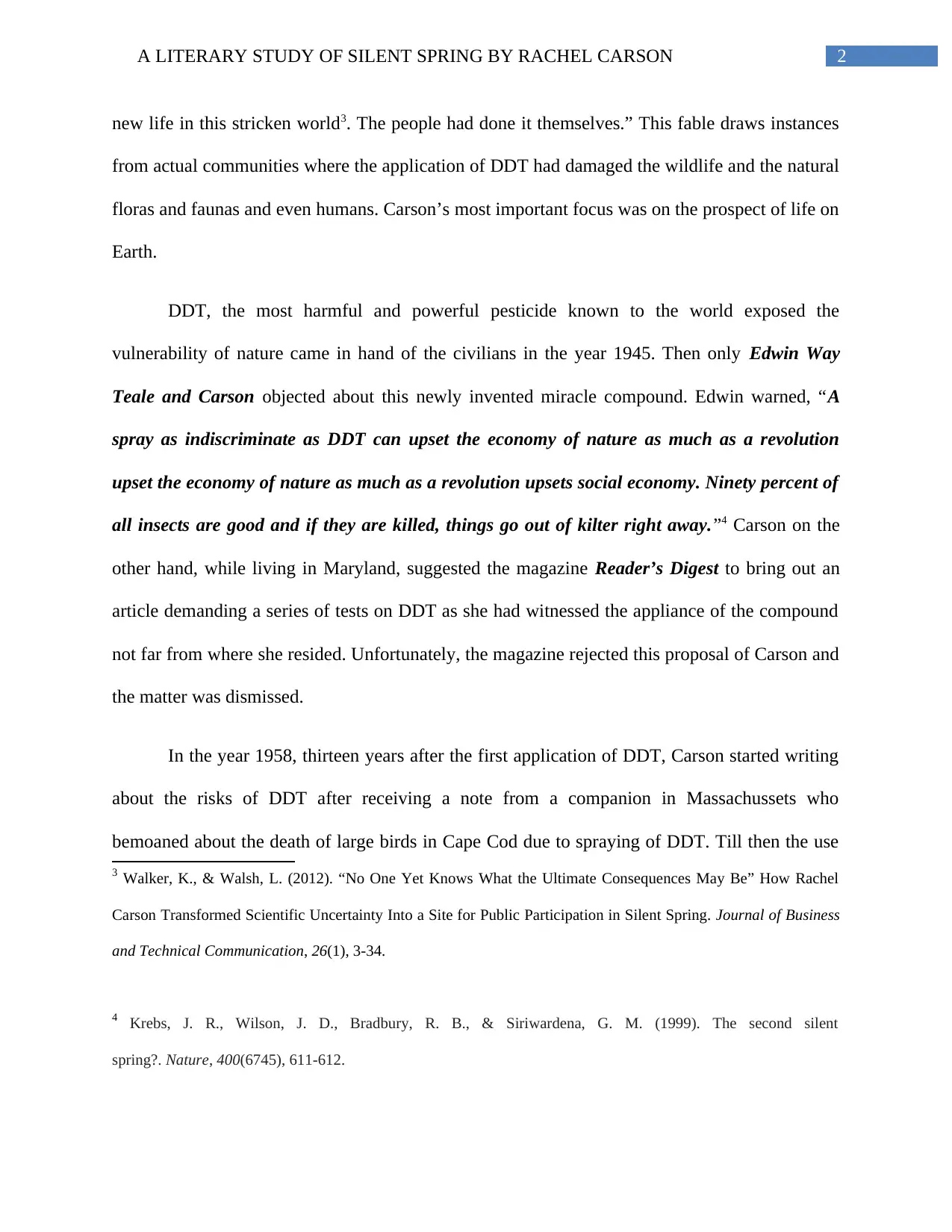
2A LITERARY STUDY OF SILENT SPRING BY RACHEL CARSON
new life in this stricken world3. The people had done it themselves.” This fable draws instances
from actual communities where the application of DDT had damaged the wildlife and the natural
floras and faunas and even humans. Carson’s most important focus was on the prospect of life on
Earth.
DDT, the most harmful and powerful pesticide known to the world exposed the
vulnerability of nature came in hand of the civilians in the year 1945. Then only Edwin Way
Teale and Carson objected about this newly invented miracle compound. Edwin warned, “A
spray as indiscriminate as DDT can upset the economy of nature as much as a revolution
upset the economy of nature as much as a revolution upsets social economy. Ninety percent of
all insects are good and if they are killed, things go out of kilter right away.”4 Carson on the
other hand, while living in Maryland, suggested the magazine Reader’s Digest to bring out an
article demanding a series of tests on DDT as she had witnessed the appliance of the compound
not far from where she resided. Unfortunately, the magazine rejected this proposal of Carson and
the matter was dismissed.
In the year 1958, thirteen years after the first application of DDT, Carson started writing
about the risks of DDT after receiving a note from a companion in Massachussets who
bemoaned about the death of large birds in Cape Cod due to spraying of DDT. Till then the use
3 Walker, K., & Walsh, L. (2012). “No One Yet Knows What the Ultimate Consequences May Be” How Rachel
Carson Transformed Scientific Uncertainty Into a Site for Public Participation in Silent Spring. Journal of Business
and Technical Communication, 26(1), 3-34.
4 Krebs, J. R., Wilson, J. D., Bradbury, R. B., & Siriwardena, G. M. (1999). The second silent
spring?. Nature, 400(6745), 611-612.
new life in this stricken world3. The people had done it themselves.” This fable draws instances
from actual communities where the application of DDT had damaged the wildlife and the natural
floras and faunas and even humans. Carson’s most important focus was on the prospect of life on
Earth.
DDT, the most harmful and powerful pesticide known to the world exposed the
vulnerability of nature came in hand of the civilians in the year 1945. Then only Edwin Way
Teale and Carson objected about this newly invented miracle compound. Edwin warned, “A
spray as indiscriminate as DDT can upset the economy of nature as much as a revolution
upset the economy of nature as much as a revolution upsets social economy. Ninety percent of
all insects are good and if they are killed, things go out of kilter right away.”4 Carson on the
other hand, while living in Maryland, suggested the magazine Reader’s Digest to bring out an
article demanding a series of tests on DDT as she had witnessed the appliance of the compound
not far from where she resided. Unfortunately, the magazine rejected this proposal of Carson and
the matter was dismissed.
In the year 1958, thirteen years after the first application of DDT, Carson started writing
about the risks of DDT after receiving a note from a companion in Massachussets who
bemoaned about the death of large birds in Cape Cod due to spraying of DDT. Till then the use
3 Walker, K., & Walsh, L. (2012). “No One Yet Knows What the Ultimate Consequences May Be” How Rachel
Carson Transformed Scientific Uncertainty Into a Site for Public Participation in Silent Spring. Journal of Business
and Technical Communication, 26(1), 3-34.
4 Krebs, J. R., Wilson, J. D., Bradbury, R. B., & Siriwardena, G. M. (1999). The second silent
spring?. Nature, 400(6745), 611-612.
⊘ This is a preview!⊘
Do you want full access?
Subscribe today to unlock all pages.

Trusted by 1+ million students worldwide
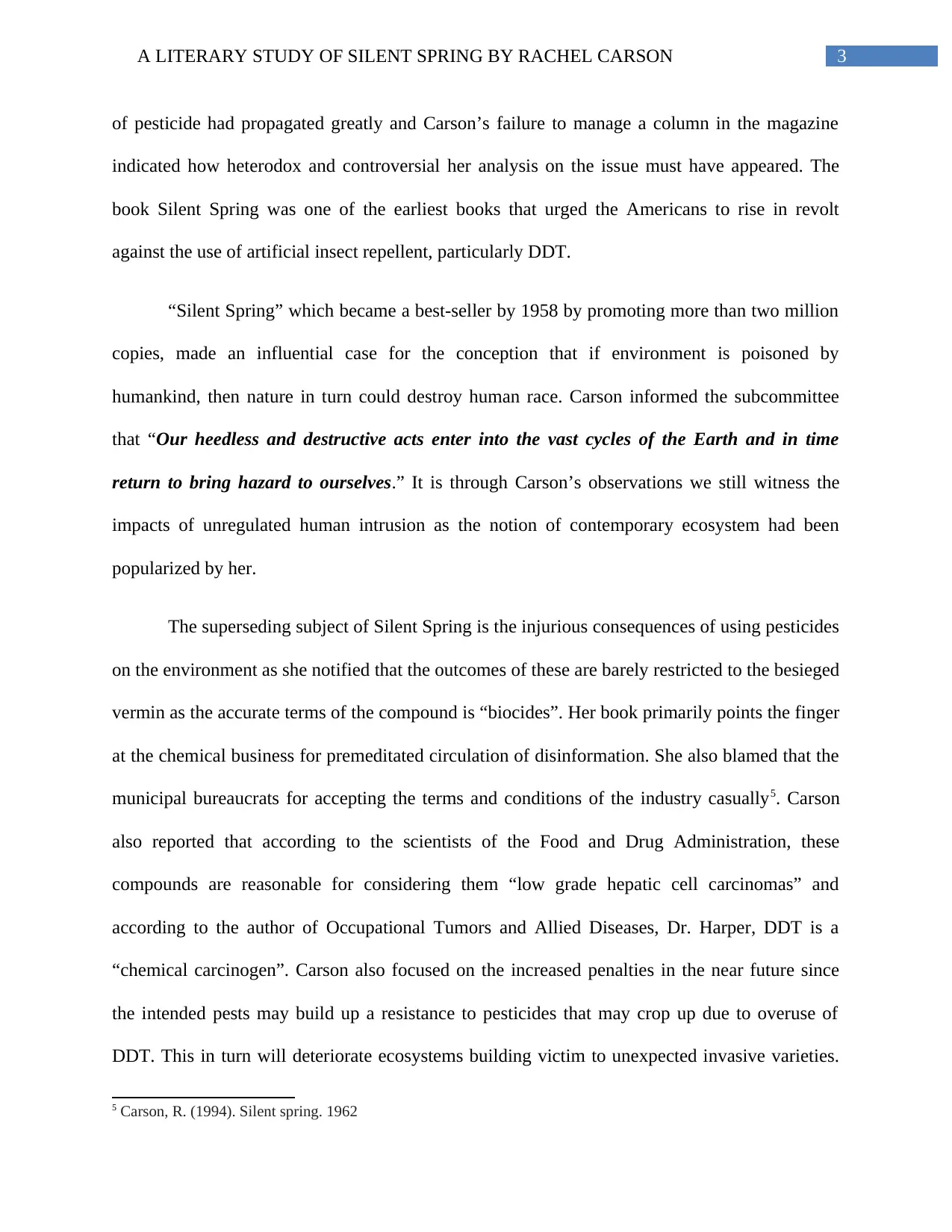
3A LITERARY STUDY OF SILENT SPRING BY RACHEL CARSON
of pesticide had propagated greatly and Carson’s failure to manage a column in the magazine
indicated how heterodox and controversial her analysis on the issue must have appeared. The
book Silent Spring was one of the earliest books that urged the Americans to rise in revolt
against the use of artificial insect repellent, particularly DDT.
“Silent Spring” which became a best-seller by 1958 by promoting more than two million
copies, made an influential case for the conception that if environment is poisoned by
humankind, then nature in turn could destroy human race. Carson informed the subcommittee
that “Our heedless and destructive acts enter into the vast cycles of the Earth and in time
return to bring hazard to ourselves.” It is through Carson’s observations we still witness the
impacts of unregulated human intrusion as the notion of contemporary ecosystem had been
popularized by her.
The superseding subject of Silent Spring is the injurious consequences of using pesticides
on the environment as she notified that the outcomes of these are barely restricted to the besieged
vermin as the accurate terms of the compound is “biocides”. Her book primarily points the finger
at the chemical business for premeditated circulation of disinformation. She also blamed that the
municipal bureaucrats for accepting the terms and conditions of the industry casually5. Carson
also reported that according to the scientists of the Food and Drug Administration, these
compounds are reasonable for considering them “low grade hepatic cell carcinomas” and
according to the author of Occupational Tumors and Allied Diseases, Dr. Harper, DDT is a
“chemical carcinogen”. Carson also focused on the increased penalties in the near future since
the intended pests may build up a resistance to pesticides that may crop up due to overuse of
DDT. This in turn will deteriorate ecosystems building victim to unexpected invasive varieties.
5 Carson, R. (1994). Silent spring. 1962
of pesticide had propagated greatly and Carson’s failure to manage a column in the magazine
indicated how heterodox and controversial her analysis on the issue must have appeared. The
book Silent Spring was one of the earliest books that urged the Americans to rise in revolt
against the use of artificial insect repellent, particularly DDT.
“Silent Spring” which became a best-seller by 1958 by promoting more than two million
copies, made an influential case for the conception that if environment is poisoned by
humankind, then nature in turn could destroy human race. Carson informed the subcommittee
that “Our heedless and destructive acts enter into the vast cycles of the Earth and in time
return to bring hazard to ourselves.” It is through Carson’s observations we still witness the
impacts of unregulated human intrusion as the notion of contemporary ecosystem had been
popularized by her.
The superseding subject of Silent Spring is the injurious consequences of using pesticides
on the environment as she notified that the outcomes of these are barely restricted to the besieged
vermin as the accurate terms of the compound is “biocides”. Her book primarily points the finger
at the chemical business for premeditated circulation of disinformation. She also blamed that the
municipal bureaucrats for accepting the terms and conditions of the industry casually5. Carson
also reported that according to the scientists of the Food and Drug Administration, these
compounds are reasonable for considering them “low grade hepatic cell carcinomas” and
according to the author of Occupational Tumors and Allied Diseases, Dr. Harper, DDT is a
“chemical carcinogen”. Carson also focused on the increased penalties in the near future since
the intended pests may build up a resistance to pesticides that may crop up due to overuse of
DDT. This in turn will deteriorate ecosystems building victim to unexpected invasive varieties.
5 Carson, R. (1994). Silent spring. 1962
Paraphrase This Document
Need a fresh take? Get an instant paraphrase of this document with our AI Paraphraser
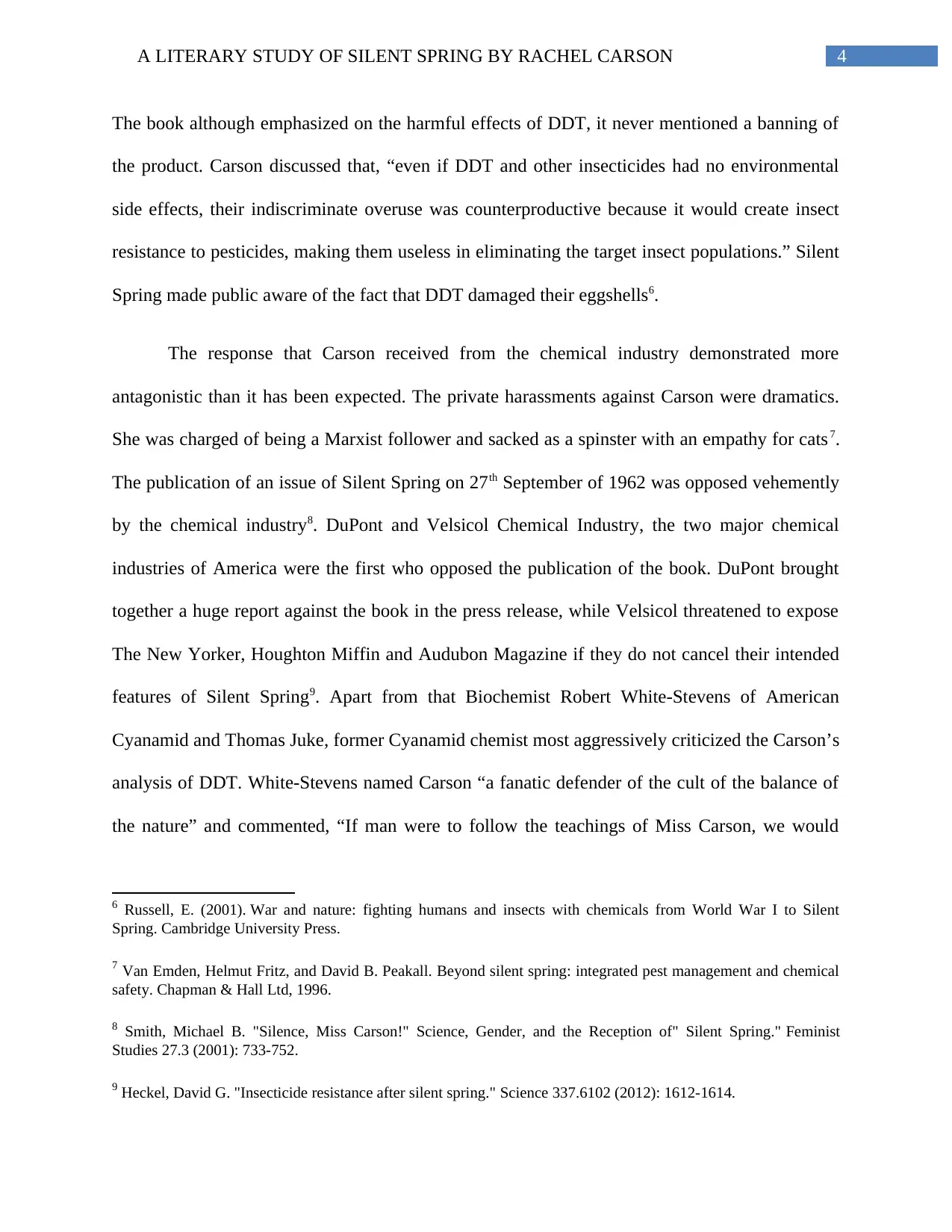
4A LITERARY STUDY OF SILENT SPRING BY RACHEL CARSON
The book although emphasized on the harmful effects of DDT, it never mentioned a banning of
the product. Carson discussed that, “even if DDT and other insecticides had no environmental
side effects, their indiscriminate overuse was counterproductive because it would create insect
resistance to pesticides, making them useless in eliminating the target insect populations.” Silent
Spring made public aware of the fact that DDT damaged their eggshells6.
The response that Carson received from the chemical industry demonstrated more
antagonistic than it has been expected. The private harassments against Carson were dramatics.
She was charged of being a Marxist follower and sacked as a spinster with an empathy for cats 7.
The publication of an issue of Silent Spring on 27th September of 1962 was opposed vehemently
by the chemical industry8. DuPont and Velsicol Chemical Industry, the two major chemical
industries of America were the first who opposed the publication of the book. DuPont brought
together a huge report against the book in the press release, while Velsicol threatened to expose
The New Yorker, Houghton Miffin and Audubon Magazine if they do not cancel their intended
features of Silent Spring9. Apart from that Biochemist Robert White-Stevens of American
Cyanamid and Thomas Juke, former Cyanamid chemist most aggressively criticized the Carson’s
analysis of DDT. White-Stevens named Carson “a fanatic defender of the cult of the balance of
the nature” and commented, “If man were to follow the teachings of Miss Carson, we would
6 Russell, E. (2001). War and nature: fighting humans and insects with chemicals from World War I to Silent
Spring. Cambridge University Press.
7 Van Emden, Helmut Fritz, and David B. Peakall. Beyond silent spring: integrated pest management and chemical
safety. Chapman & Hall Ltd, 1996.
8 Smith, Michael B. "Silence, Miss Carson!" Science, Gender, and the Reception of" Silent Spring." Feminist
Studies 27.3 (2001): 733-752.
9 Heckel, David G. "Insecticide resistance after silent spring." Science 337.6102 (2012): 1612-1614.
The book although emphasized on the harmful effects of DDT, it never mentioned a banning of
the product. Carson discussed that, “even if DDT and other insecticides had no environmental
side effects, their indiscriminate overuse was counterproductive because it would create insect
resistance to pesticides, making them useless in eliminating the target insect populations.” Silent
Spring made public aware of the fact that DDT damaged their eggshells6.
The response that Carson received from the chemical industry demonstrated more
antagonistic than it has been expected. The private harassments against Carson were dramatics.
She was charged of being a Marxist follower and sacked as a spinster with an empathy for cats 7.
The publication of an issue of Silent Spring on 27th September of 1962 was opposed vehemently
by the chemical industry8. DuPont and Velsicol Chemical Industry, the two major chemical
industries of America were the first who opposed the publication of the book. DuPont brought
together a huge report against the book in the press release, while Velsicol threatened to expose
The New Yorker, Houghton Miffin and Audubon Magazine if they do not cancel their intended
features of Silent Spring9. Apart from that Biochemist Robert White-Stevens of American
Cyanamid and Thomas Juke, former Cyanamid chemist most aggressively criticized the Carson’s
analysis of DDT. White-Stevens named Carson “a fanatic defender of the cult of the balance of
the nature” and commented, “If man were to follow the teachings of Miss Carson, we would
6 Russell, E. (2001). War and nature: fighting humans and insects with chemicals from World War I to Silent
Spring. Cambridge University Press.
7 Van Emden, Helmut Fritz, and David B. Peakall. Beyond silent spring: integrated pest management and chemical
safety. Chapman & Hall Ltd, 1996.
8 Smith, Michael B. "Silence, Miss Carson!" Science, Gender, and the Reception of" Silent Spring." Feminist
Studies 27.3 (2001): 733-752.
9 Heckel, David G. "Insecticide resistance after silent spring." Science 337.6102 (2012): 1612-1614.
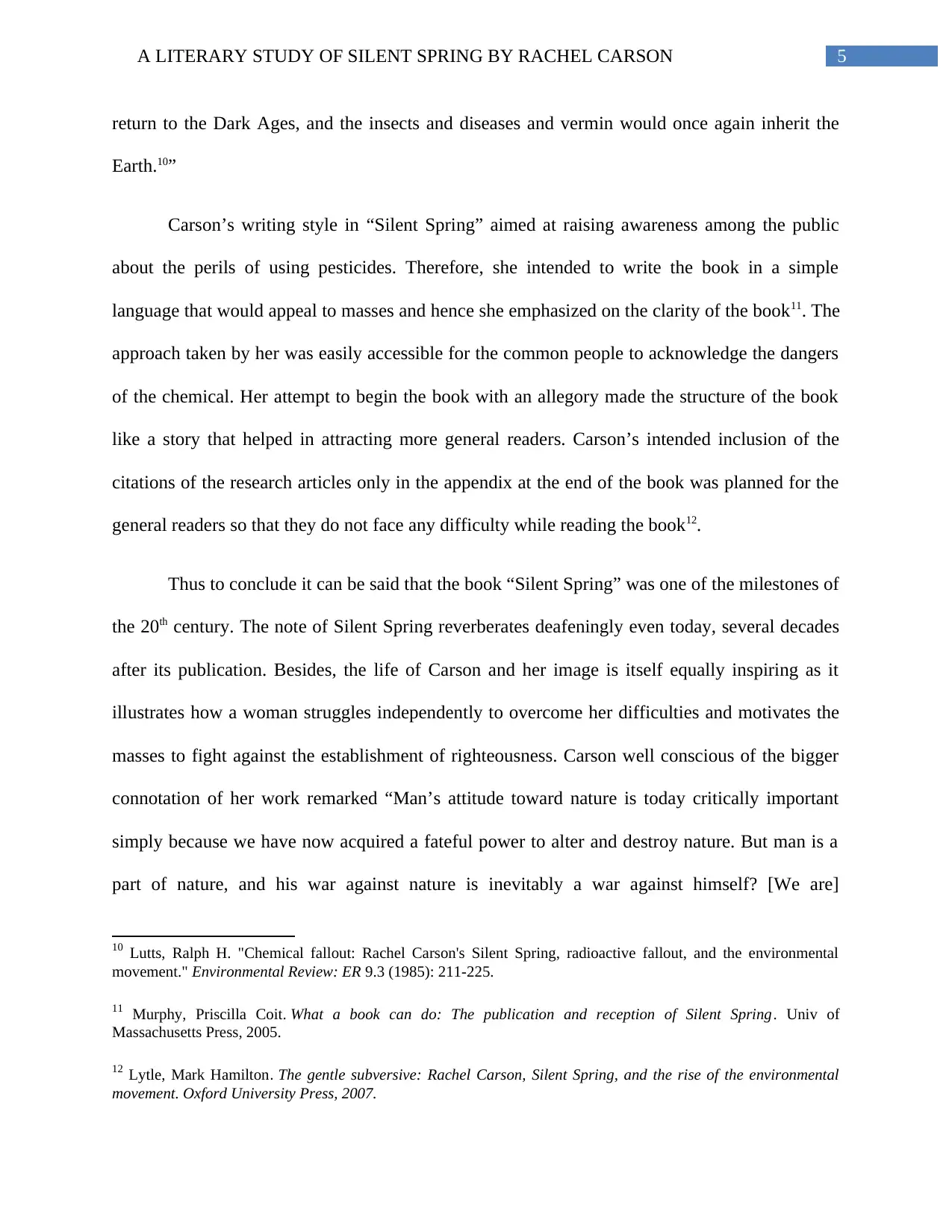
5A LITERARY STUDY OF SILENT SPRING BY RACHEL CARSON
return to the Dark Ages, and the insects and diseases and vermin would once again inherit the
Earth.10”
Carson’s writing style in “Silent Spring” aimed at raising awareness among the public
about the perils of using pesticides. Therefore, she intended to write the book in a simple
language that would appeal to masses and hence she emphasized on the clarity of the book11. The
approach taken by her was easily accessible for the common people to acknowledge the dangers
of the chemical. Her attempt to begin the book with an allegory made the structure of the book
like a story that helped in attracting more general readers. Carson’s intended inclusion of the
citations of the research articles only in the appendix at the end of the book was planned for the
general readers so that they do not face any difficulty while reading the book12.
Thus to conclude it can be said that the book “Silent Spring” was one of the milestones of
the 20th century. The note of Silent Spring reverberates deafeningly even today, several decades
after its publication. Besides, the life of Carson and her image is itself equally inspiring as it
illustrates how a woman struggles independently to overcome her difficulties and motivates the
masses to fight against the establishment of righteousness. Carson well conscious of the bigger
connotation of her work remarked “Man’s attitude toward nature is today critically important
simply because we have now acquired a fateful power to alter and destroy nature. But man is a
part of nature, and his war against nature is inevitably a war against himself? [We are]
10 Lutts, Ralph H. "Chemical fallout: Rachel Carson's Silent Spring, radioactive fallout, and the environmental
movement." Environmental Review: ER 9.3 (1985): 211-225.
11 Murphy, Priscilla Coit. What a book can do: The publication and reception of Silent Spring. Univ of
Massachusetts Press, 2005.
12 Lytle, Mark Hamilton. The gentle subversive: Rachel Carson, Silent Spring, and the rise of the environmental
movement. Oxford University Press, 2007.
return to the Dark Ages, and the insects and diseases and vermin would once again inherit the
Earth.10”
Carson’s writing style in “Silent Spring” aimed at raising awareness among the public
about the perils of using pesticides. Therefore, she intended to write the book in a simple
language that would appeal to masses and hence she emphasized on the clarity of the book11. The
approach taken by her was easily accessible for the common people to acknowledge the dangers
of the chemical. Her attempt to begin the book with an allegory made the structure of the book
like a story that helped in attracting more general readers. Carson’s intended inclusion of the
citations of the research articles only in the appendix at the end of the book was planned for the
general readers so that they do not face any difficulty while reading the book12.
Thus to conclude it can be said that the book “Silent Spring” was one of the milestones of
the 20th century. The note of Silent Spring reverberates deafeningly even today, several decades
after its publication. Besides, the life of Carson and her image is itself equally inspiring as it
illustrates how a woman struggles independently to overcome her difficulties and motivates the
masses to fight against the establishment of righteousness. Carson well conscious of the bigger
connotation of her work remarked “Man’s attitude toward nature is today critically important
simply because we have now acquired a fateful power to alter and destroy nature. But man is a
part of nature, and his war against nature is inevitably a war against himself? [We are]
10 Lutts, Ralph H. "Chemical fallout: Rachel Carson's Silent Spring, radioactive fallout, and the environmental
movement." Environmental Review: ER 9.3 (1985): 211-225.
11 Murphy, Priscilla Coit. What a book can do: The publication and reception of Silent Spring. Univ of
Massachusetts Press, 2005.
12 Lytle, Mark Hamilton. The gentle subversive: Rachel Carson, Silent Spring, and the rise of the environmental
movement. Oxford University Press, 2007.
⊘ This is a preview!⊘
Do you want full access?
Subscribe today to unlock all pages.

Trusted by 1+ million students worldwide
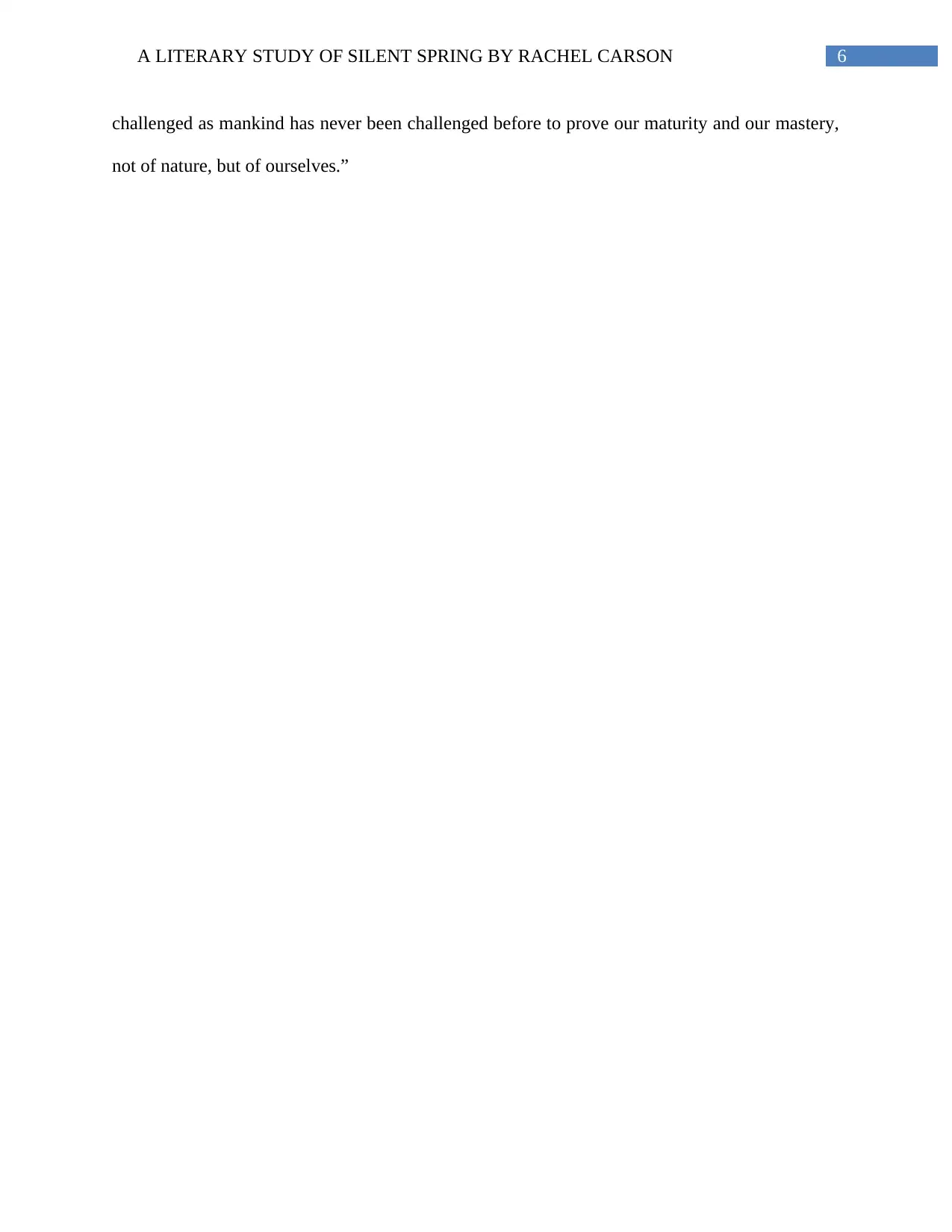
6A LITERARY STUDY OF SILENT SPRING BY RACHEL CARSON
challenged as mankind has never been challenged before to prove our maturity and our mastery,
not of nature, but of ourselves.”
challenged as mankind has never been challenged before to prove our maturity and our mastery,
not of nature, but of ourselves.”
Paraphrase This Document
Need a fresh take? Get an instant paraphrase of this document with our AI Paraphraser
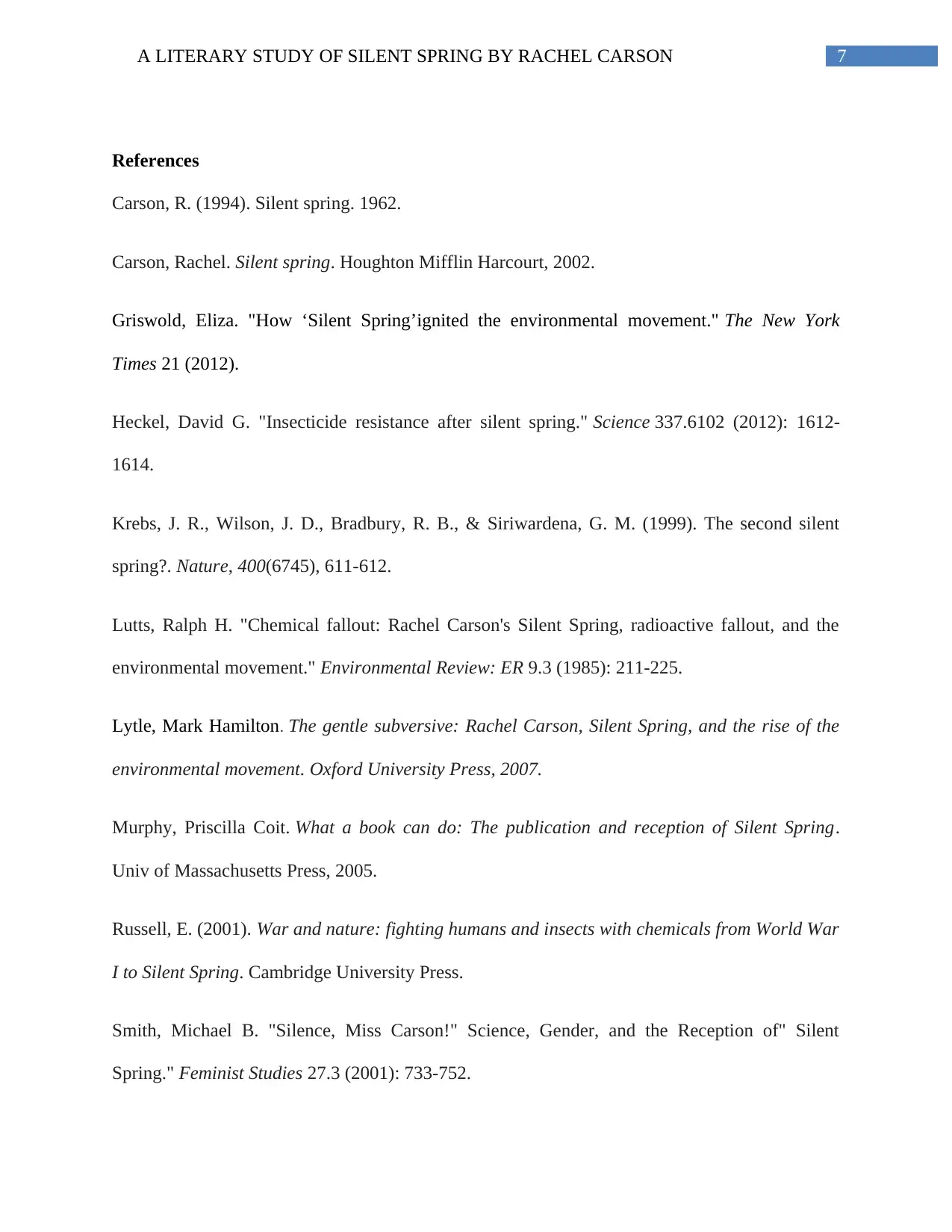
7A LITERARY STUDY OF SILENT SPRING BY RACHEL CARSON
References
Carson, R. (1994). Silent spring. 1962.
Carson, Rachel. Silent spring. Houghton Mifflin Harcourt, 2002.
Griswold, Eliza. "How ‘Silent Spring’ignited the environmental movement." The New York
Times 21 (2012).
Heckel, David G. "Insecticide resistance after silent spring." Science 337.6102 (2012): 1612-
1614.
Krebs, J. R., Wilson, J. D., Bradbury, R. B., & Siriwardena, G. M. (1999). The second silent
spring?. Nature, 400(6745), 611-612.
Lutts, Ralph H. "Chemical fallout: Rachel Carson's Silent Spring, radioactive fallout, and the
environmental movement." Environmental Review: ER 9.3 (1985): 211-225.
Lytle, Mark Hamilton. The gentle subversive: Rachel Carson, Silent Spring, and the rise of the
environmental movement. Oxford University Press, 2007.
Murphy, Priscilla Coit. What a book can do: The publication and reception of Silent Spring.
Univ of Massachusetts Press, 2005.
Russell, E. (2001). War and nature: fighting humans and insects with chemicals from World War
I to Silent Spring. Cambridge University Press.
Smith, Michael B. "Silence, Miss Carson!" Science, Gender, and the Reception of" Silent
Spring." Feminist Studies 27.3 (2001): 733-752.
References
Carson, R. (1994). Silent spring. 1962.
Carson, Rachel. Silent spring. Houghton Mifflin Harcourt, 2002.
Griswold, Eliza. "How ‘Silent Spring’ignited the environmental movement." The New York
Times 21 (2012).
Heckel, David G. "Insecticide resistance after silent spring." Science 337.6102 (2012): 1612-
1614.
Krebs, J. R., Wilson, J. D., Bradbury, R. B., & Siriwardena, G. M. (1999). The second silent
spring?. Nature, 400(6745), 611-612.
Lutts, Ralph H. "Chemical fallout: Rachel Carson's Silent Spring, radioactive fallout, and the
environmental movement." Environmental Review: ER 9.3 (1985): 211-225.
Lytle, Mark Hamilton. The gentle subversive: Rachel Carson, Silent Spring, and the rise of the
environmental movement. Oxford University Press, 2007.
Murphy, Priscilla Coit. What a book can do: The publication and reception of Silent Spring.
Univ of Massachusetts Press, 2005.
Russell, E. (2001). War and nature: fighting humans and insects with chemicals from World War
I to Silent Spring. Cambridge University Press.
Smith, Michael B. "Silence, Miss Carson!" Science, Gender, and the Reception of" Silent
Spring." Feminist Studies 27.3 (2001): 733-752.
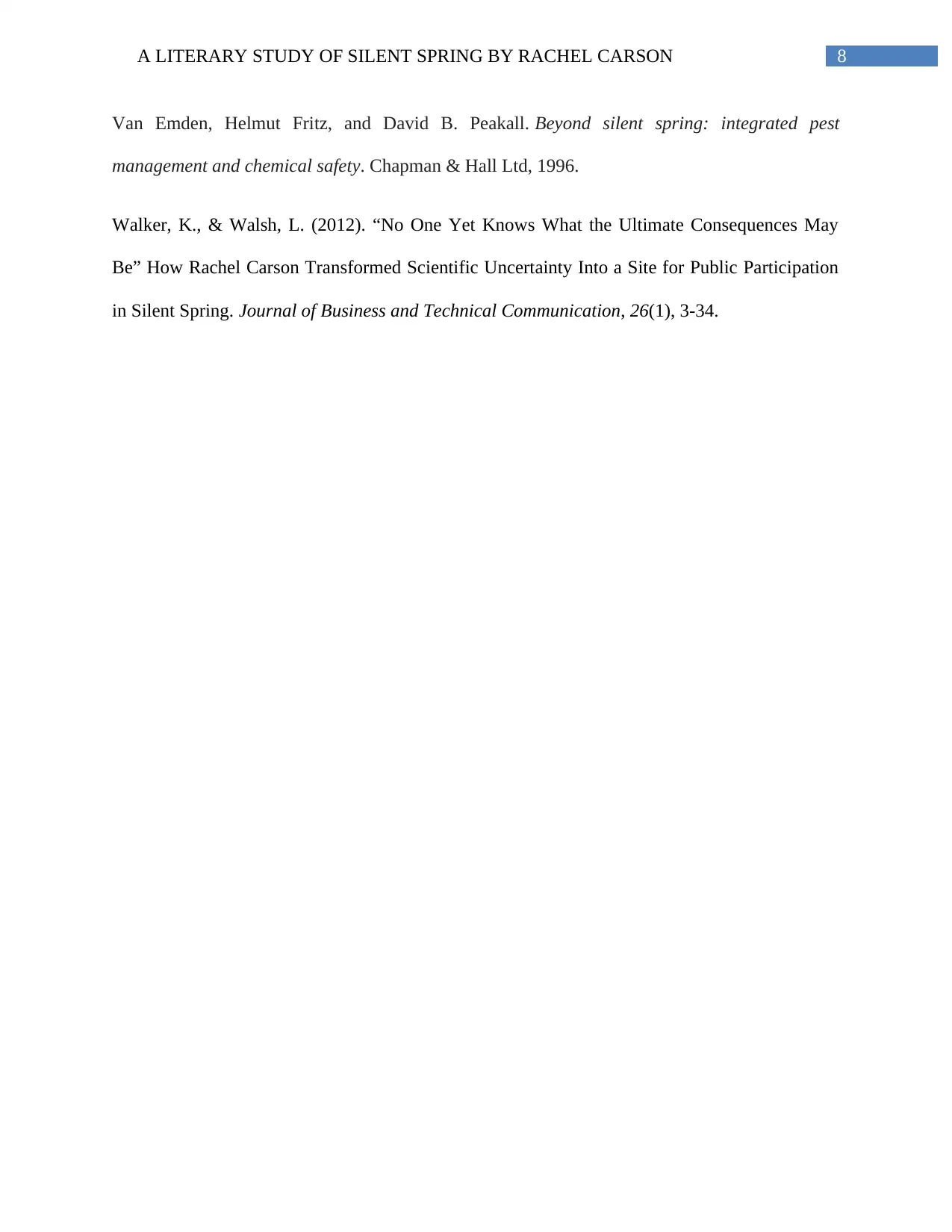
8A LITERARY STUDY OF SILENT SPRING BY RACHEL CARSON
Van Emden, Helmut Fritz, and David B. Peakall. Beyond silent spring: integrated pest
management and chemical safety. Chapman & Hall Ltd, 1996.
Walker, K., & Walsh, L. (2012). “No One Yet Knows What the Ultimate Consequences May
Be” How Rachel Carson Transformed Scientific Uncertainty Into a Site for Public Participation
in Silent Spring. Journal of Business and Technical Communication, 26(1), 3-34.
Van Emden, Helmut Fritz, and David B. Peakall. Beyond silent spring: integrated pest
management and chemical safety. Chapman & Hall Ltd, 1996.
Walker, K., & Walsh, L. (2012). “No One Yet Knows What the Ultimate Consequences May
Be” How Rachel Carson Transformed Scientific Uncertainty Into a Site for Public Participation
in Silent Spring. Journal of Business and Technical Communication, 26(1), 3-34.
⊘ This is a preview!⊘
Do you want full access?
Subscribe today to unlock all pages.

Trusted by 1+ million students worldwide
1 out of 9
Your All-in-One AI-Powered Toolkit for Academic Success.
+13062052269
info@desklib.com
Available 24*7 on WhatsApp / Email
![[object Object]](/_next/static/media/star-bottom.7253800d.svg)
Unlock your academic potential
Copyright © 2020–2025 A2Z Services. All Rights Reserved. Developed and managed by ZUCOL.